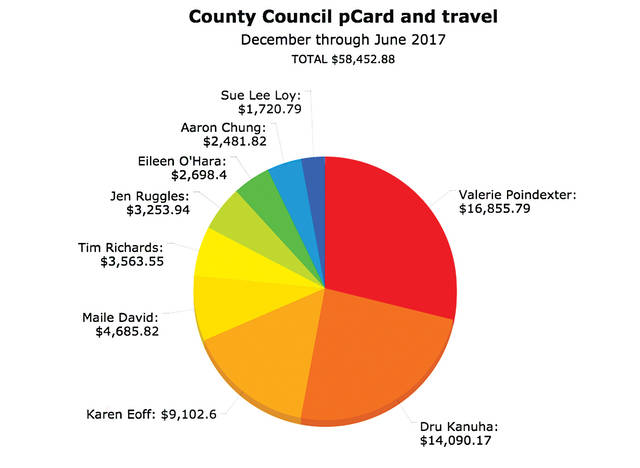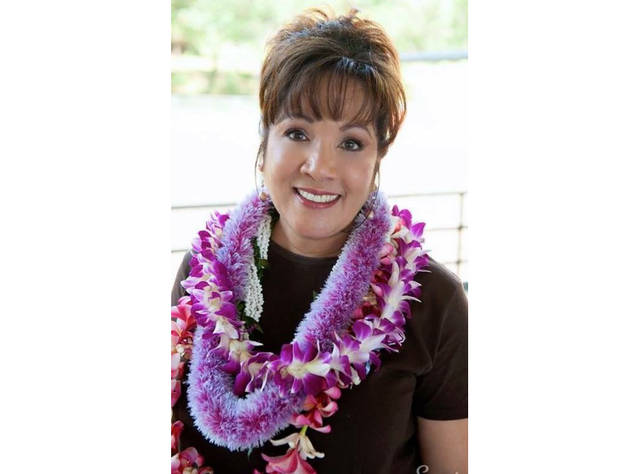Editor’s note: This is part one in a two-part series examining county spending. Monday’s story analyzes Mayor Harry Kim’s spending.
Some County Council members are flying high on the taxpayers’ dime.
The council spent $58,453 on travel during the first seven months of the two-year term, almost twice the monthly average of prior years, according to a West Hawaii Today analysis of purchasing card and travel records.
From newbies to seasoned travelers, the council’s nine members have all gone off-island at least once since they took or resumed office in December. One council member made three mainland trips; another made two mainland trips and is now in Japan.
Council members justify the taxpayer expense, especially for conferences of the National Association of Counties and the Hawaii State Association of Counties.
“It’s not a big vacation,” said Hilo Councilman Aaron Chung. “It’s more networking, seeing how different states and towns handle things. There could be something we could incorporate on our island.”
Chung hasn’t attended conferences this year, traveling only to Honolulu to lobby the Legislature. His travel expenses of $2,482 are second-lowest only to fellow Hilo council member Sue Lee Loy, who had the lowest expenses at $1,721. The analysis covered December through June.
The most frequent flier is Council Chairwoman Valerie Poindexter, whose travel expenses totaled $16,856 and included 37 days off-island during the 212-day period. The total doesn’t include Poindexter’s current seven-day trip to sister city Ikaho, Japan, which is holding a Merrie Monarch festival. She’s due to return Monday.
Closer to home, council members said the annual HSAC event, this year held on Kauai, is well worth the money. Seven council members attended. Among important issues discussed at the event, said Lee Loy and Puna Councilwoman Eileen O’Hara, was a session on property tax classifications and how other counties have a category for vacation rentals, something the Hawaii council is considering.
Speeches by state Senate President Ron Kouchi and House Speaker Scott Saiki were especially helpful, they said, in understanding the state perspective on the counties’ share of the transient accommodations tax, an issue that will be the focus of a special session of the state Legislature next month.
Poindexter so far this year has been to Washington, D.C., twice, once for the annual NACo conference and once for Hawaii on the Hill, a lobbying day organized by the Hawaii Chamber of Commerce. She’s also been to Honolulu 11 times, in addition to trips to Maui and Kauai, all at county expense.
“The chair represents us all over the place,” said O’Hara, whose $2,698 expenses were also in the bottom third.
Honolulu trips for Poindexter included opening day for the state Legislature, Gov. David Ige’s State of the State address, the inauguration of the Honolulu City Council, a banquet honoring Japan Prime Minister Shinzo Abe, a University of Hawaii College of Tropical Agriculture and Human Resources banquet honoring Big Island resident Eric Tanouye, several HSAC meetings, testimony before legislative committees on the transient accommodations tax and meetings about a proposed dairy in Ookala, which is in Poindexter’s district.
Poindexter visited Maui twice at county expense — once for its county council inauguration and once to attend a speech by Oprah Winfrey. She went to Kauai for the annual HSAC conference.
“In my capacity as chairwoman, I have been invited to represent the council at a large number of events, besides traveling for important legislative purposes that all benefit the people of Hawaii Island,” Poindexter said. “Many good things are starting to evolve because of the investments made through my travel.”
Poindexter said one of her priorities is preparing the county for the upcoming “silver tsunami” of an aging population. As a member of the NACo health steering committee, her travel has helped her focus on that issue, she said. Making important contacts at social events also helps the county, she said.
“Taking advantage of my travel opportunities with all levels of government as well as the private sector, I have started on a public-private partnership that could make senior care more affordable and able to focus specifically on elderly care as they age through the last phase of their life with dignity,” Poindexter said.
For two council members, taxpayer-backed travel has been their only experience leaving the state.
South Kona/Ka‘u Councilwoman Maile David, 65, didn’t go to the mainland this year, but she went last year, attending the NACo conference in Washington, D.C.
David said she had to be coaxed to go. She’s glad she went, but she doesn’t plan to go again, she said.
“It’s an experience,” David said. “It just gave a sense of how huge a role government plays.”
Hilo Councilwoman Jen Ruggles, 28, had her first out-of-state trip this year, flying to the NACo conference with Poindexter, Kona Councilman Dru Kanuha and North Kona Councilwoman Karen Eoff. Eoff said the three women shared a hotel room to save money.
Kanuha, who frequently travels as a board member for both HSAC and NACo, came in second in total expenses, with $14,091 for the seven-month period. Kanuha is required to attend meetings in Honolulu, for which he’s reimbursed by HSAC. He’s also reimbursed $2,000 per trip for out-of-state NACo events.
Even with reimbursements from those organizations, however, Kanuha’s expenses came in second-highest. His trips included three to the mainland.
Recently named HSAC president, Kanuha praised both that organization and NACo for benefiting county government. For example, he said, their recent lobbying of Congress saved a program where the federal government makes a payment for its land that’s off the county tax rolls and brought Hawaii County more than $320,000 for 2017.
“It is extremely important to coordinate legislative priorities on behalf of all the counties,” Kanuha said. “HSAC and NACo work to make sure that the counties’ voices are at the forefront when dealing with state and federal legislation that affects each county. NACo has testified before Congress and met with members regarding issues of importance to counties across America.”
Hawaii County Council members’ travel costs may be higher than some on other islands. Council meetings are generally held once monthly in Kona and once monthly in Hilo. That means council members stay one or two nights a month at either a Kona or Hilo hotel, depending where they live.
Hotel rooms in Kona tend to run about $170 nightly; those in Hilo, about $130 at the government rate. Council members are also paid per diem for food. West Hawaii council members may spend more than their East Hawaii counterparts for council meetings because budget sessions and other special meetings are held in Hilo.
The newspaper obtained the council’s and top administrators’ pCard statements under Hawaii’s Uniform Information Practices Act as a follow-up to a 2015 breaking story by West Hawaii Today and further analysis conducted by its sister newspaper, the Hawaii Tribune-Herald.
The 2015 newspaper analyses, and a subsequent audit by Legislative Auditor Bonnie Nims, showed very few personal purchases on County Council members’ pCards, and relatively prompt reimbursement when purchases were inappropriately charged. That still seems the case.
The County Council and Mayor Harry Kim subsequently instituted a no-alcohol policy for county purchases.
Among the other procedures for the council is the requirement that travel be approved in advance by the council chairman, as well as requirements that flights be at the coach rate and motel rooms at the standard rate.
Receipts are required for charges. In the case of lost receipts, duplicates must be notarized. Council members can opt for a flat per diem rate of $90 daily for instate travel or $145 daily for out-of-state travel instead of accruing charges. The per diem must be requested in advance, and must be reimbursed if the charges are accrued instead.
The high volume of pCard use in Hawaii County could present opportunities for saving money, according to Nims.
Using a pCard for county purchases can also protect the county from liability, the council learned last week. A stolen rental car resulted in the county’s self-insurance fund being charged $2,000, but if the employee had used a pCard, the penalty would have been insured by the bank, an attorney said.
Still, with the two island newspapers’ investigation fresh in their minds, several county officials said they think twice before spending money on their pCards.
“Every time I reach into my wallet for the pCard, I think of you,” a staffer told a West Hawaii Today reporter last week.
Email Nancy Cook Lauer at ncook-lauer@westhawaiitoday.com









